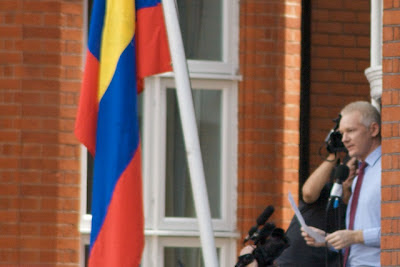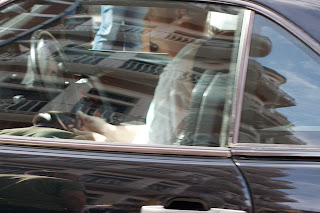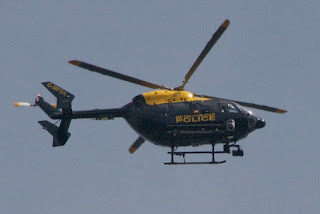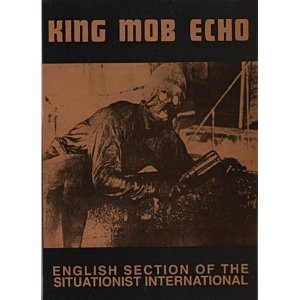 |
| Voina: "Dick in FSB Captivity" |
Gavin Grindon claimed that most Art
Activism merely mimics activism in a "context without consequences". He
also tells us that at while Art Activism is currently very popular,
drawing down funding and support from liberal art institutions, it is
also being criminalised and excluded as 'terrorist' by political
establishments: the legal definition of 'terrorism' being extended to include non-violent civil disobedience: the 'eco-terrorist' for example (Art Monthly 2010 #333 pp 9-12). Art Activism sits in a difficult position: if it merely re-presents social conflict in a gallery setting, or within the gallery system, it can come across as just playing with real, big issues and have no real impact. On the other hand, as Boris Groys points out (Art Power 2008), if art becomes embroiled in politics and creating social change it risks becoming mere activism (and losing the 'art'). The Voina art collective raises the question of how contemporary practice can straddle this boundary of making socio-political art with an impact that can also be judged aesthetically - 'as art'.
Voina (which means "War" in Russian) is a Russian art collective, founded in 2006 by husband and wife Oleg Vorotnikov and Natalia Sokol. Other key members include 'Preseident' Leonid Nikolayev and Alexei Plutser-Sarno (AKA Plucer). As with previous examples of militant art on this blog, Voina operate in the Dadaist tradition. Examples of their performances include:
 |
| How to snatch a chicken: the tale of how one cunt fed all of Voina |
a live public orgy at the State Biological Museum to mock the election of Dmitry Medvedev; a 180-foot-high projection of a skull-and-crossbones on the
exterior of Russia's parliament; theft of a supermarket chicken by inserting it into a member's vagina; flipping police cars over; setting fire to a prison transport van; and painting an enormous cock on a
drawbridge facing a police building (formerly the KGB Head Quarters) in St. Petersburg.
One of Voina's supporters, the radical curator Andrei V. Yerofeyev, was fined...
for "inciting religious hatred" in connection with a show of "Forbidden Art" he co-curated Moscow's Sakharov Museum [...] In 2009, Voina had stormed the court when charges were brought against him. Assuming the persona of a band called Cock in the Ass, Voina members performed a raucous punk song titled "All Cops are Bastards" in court as a theatrical gesture of solidarity with Yerofeyev and his co-defendant. (Art Info)
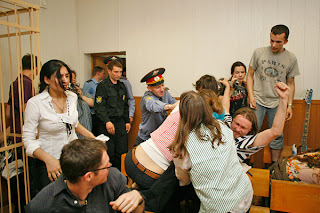 |
| Cock in Ass |
This, no doubt, reminds us of a more familiar political protest in Russia (due to the current high levels of media coverage): that of the female Punk Band
Pussy Riot
who have been sentenced for two years for performing a protest song
(which may have featured bad language and anti-Putin sentiments) in a
cathedral. Voina, despite their more radical stunts, have so far evaded such harsh sentences. Two members, imprisoned for their role in
Palace Revolution (where they up-turned Police cars in St. Petersburg) were released in March after
Banksy rasied their £90K bail money from an online auction of his work. The BBC described "Palace Revolution" as involving:
...31 activists; five to do the heavy lifting, while the rest filmed what was happening, acted as lookouts and distracted the police by pretending to be lost tourists.(BBC)
While Grindon draws our attention to the use of anti-terrorist laws against the likes of Green Peace, with the likes of Pussy Riot and Voina we
have seen charges of political, racial, religious or ideological hatred
levied at the artists (you know you're in trouble when they pull that one out...
it's like health and safety... no one feels they have the authority to
challenge it). Just making a protest wouldn't get Pussy Riot put
in prison - but if the protest (in a cathedral) were to be interpreted
as being motivated by religious hatred... This is the danger of puritan
attitudes towards Islamophobia - suddenly a comment or action can be
exacerbated and you can be attacked as an extremist
(extremist/terrorist, it doesn't matter which). This is worrying indeed
as we are already in a situation where only a very narrow spectrum of
political ideologies is deemed acceptable - in the US 'Liberal' is a
dirty word on a par with 'communist' nearly (imagine the horror!). In
the UK we have no real left wing parties anymore (you can't really call
Respect a party and Labour/Lib Dems are committed free-marketeers),
while on the right UKIP are considered acceptable (just about). The lack
of democratic representation drives people towards the English Defense
League, British National Party (although they've recently taken a
kicking) or the National Front.
Voina are currently on the run. Although they are wanted by
Interpol, they managed to co-curate this year's
Berlin Biennale with Artur Żmijewski, who organised
political actions for the Biennale supporting causes including freeing Belarus’ political
prisoners, the Occupy Movement, and opposing the recent international arrest warrants issued
for Oleg Vornikov and Natalia Sokol.
So, how do Voina address Grindon's accusation that art activism cannot "make a difference" and/or Groys's position that if it does "make a difference" it risks losing its status as art?
Take the example of fire-bombing a Police transport: this is clearly a militant and illegal activity. It is, perhaps, more easily accepted as activism than art. Voina member Alexei Plutser-Sarno explains that by burning it the group “stirred up discussion” in the entire country [... and that such] actions are an adequate reaction to all those batteries, tortures and
arrests of innocent people, to the situation when thousands of political
prisoners are kept in jails all over the country.” Writing for Art Info (January 2012) Kyle Chayka, Alexander Forbes sum up Voina's position on the definition of art:
the difference between performance art and political
activism is art’s public nature and the importance of laying claim to
your work. “If an activist secretly burns a cop truck at night, it won’t
be art. It will be the revenge of an activist,” Plutser-Sarno wrote.
“But to burn it openly and proclaim to the entire country: ‘I am an
artist. I burned down your prison, symbol of totalitarianism. This
autodafe is our art action,’ then it becomes a piece of art. We made
people discuss it as an artistic action.”(Art Info) [Plutser-Sarno is currently in hiding abroad].
 |
| Crazy Leo |
This definition is not incompatible with
US artist Mel Chin who, speaking about his activist art piece
Operation Paydirt (which aimed to find a solution for the high lead contamination in the soil surrounding New Orleans) told Claire Bishop that his work can be judged aesthetically and politically as a landscape without lead pollution would be beautiful. Another action at first seems less militant and more Dadaist. Leonid (crazy Leo) Nikolayev climbs onto a police car with a blue bucket on his head "to protest against the widespread use of blue emergency lights by
officials who cannot be bothered to sit in Moscow traffic jams" (
BBC). He then runs blind down busy streets trying to avoid arrest: a police officer pulls the bucket off his head only to reveal another, smaller, blue bucket. This may seem comical and absurd (and it is) but it also fits into an anarchist tradition in that it challenges authority and by 'doing' helps others to see that we can be more free, live without fear and be braver.
 |
| Decembrists Commemoration: Public Execution in the Supermarket |
There are many more examples which I do not have the time to recount here (but videos can be seen on
Plucer's own blog). Here are a few of the more outrageous stunts. Judge for yourselves, but we here at Malaised feel that Voina are one of the most ground-breaking and cutting edge performance art activists in the world right now:
In
Decembrists Commemoration Voina staged the mock lynching of five people in Moscow's largest supermarket. The five victims represented Jews, Central Asian Immigrants, and homosexuals - "a special gift to the Russian corrupted authorities, who incite homophobia, misanthropy and anti-Semitism; as a result the killings of Central Asians guest workers [...] have become an everyday reality in Russia." (
Plucer). Of course, the action was also to remind Russians of the libertarian ideals of the country’s first revolutionists - the five 'Decembrists' hanged in 1826.
 |
| Cop in a cassock |
Also in a supermarket a Voina member dressed in a police uniform covered by a Russian Orthodox cassock and large cross, shoplifted alcohol and food "with the impunity enjoyed by priests and cops in today’s Russia". Following on with another large corporation in the food industry Voina stormed McDonald's hurling stray cats behind the counter "As a result the fast-food products were spoilt, hungry cats – fed".
 |
| Mordovian Hour |
Two days before the election of Dmitry Medvedev, Voina staged a live public orgy at the State Museum of Biology. '
While five couples were copulating, the Voina chief media artist Alexei Plutser-Sarno, wearing a tuxedo and a top-hat, was holding a black pre-electoral banner reading "Fuck for the Heir - Medvedev’s little Bear! [...] in Russia everyone fucks each other and the little president looks at it with delight". Voina mocked the farcical and pornographic elections in the country, as Medvedev just inherited the V. Putin's presidential throne".
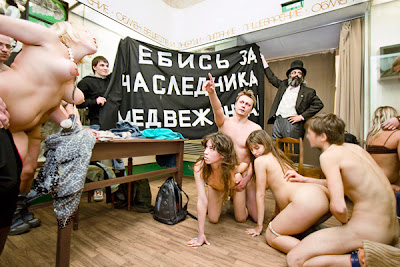 |
| Fuck for the Heir - Medvedev’s little Bear! |
Further reading:
http://www.artinfo.com/news/story/755205/voina-explains-why-firebombing-a-police-tank-is-a-piece-of-art
http://www.bbc.co.uk/news/world-europe-11982984
http://plucer.livejournal.com/531761.html#cutid1
http://www.artinfo.com/news/story/38894/escape-artist-wanted-voina-art-anarchist-outfoxes-russian-police-again-fleeing-on-his-bike/
http://www.artinfo.com/news/story/37437/police-baiting-penis-graffiti-by-radical-voina-collective-wins-14k-russian-innovation-prize/
http://www.artinfo.com/news/story/36573/banksy-bankrolls-jailed-russian-art-anarchists/
http://plucer.livejournal.com/266853.html
http://www.animalnewyork.com/2011/voina-oleg-not-arrested-but-internationally-wanted/








